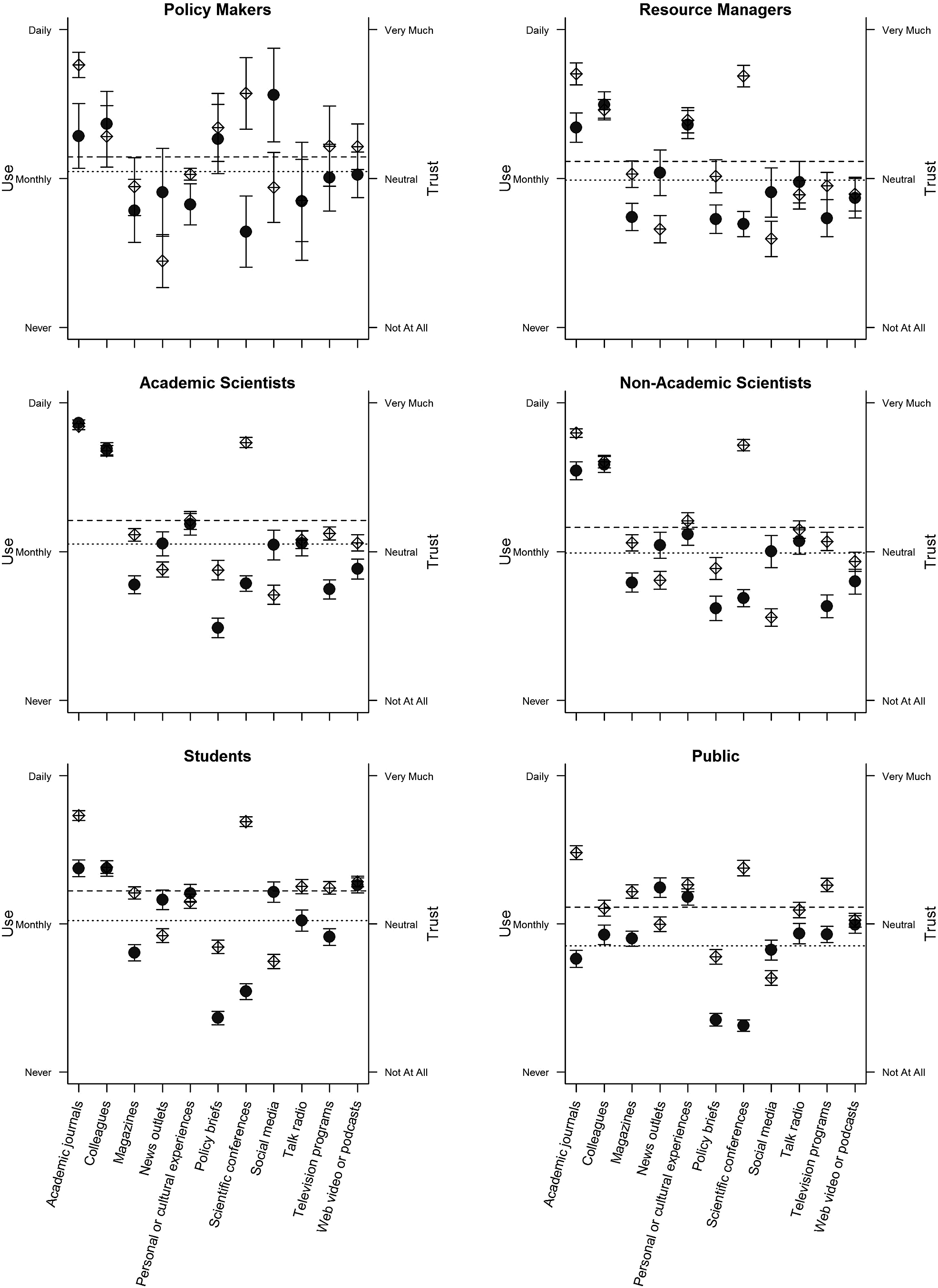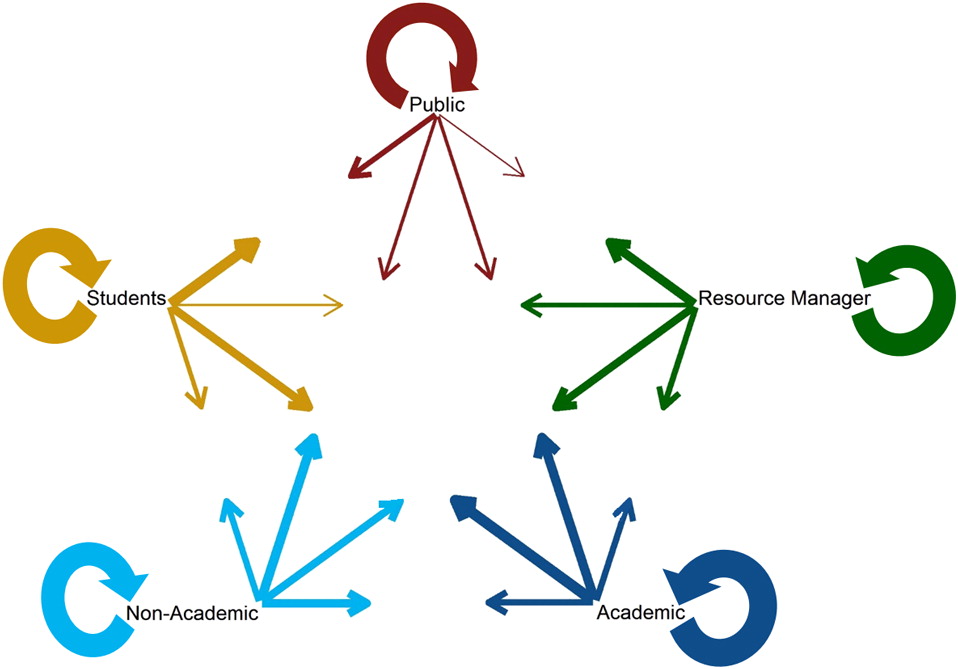Communicating science: Sending the right message to the right audience
Abstract
Introduction
Materials and methods
Statistical analyses
Results
Trust versus use
| Trust | Use | |||||
|---|---|---|---|---|---|---|
| Social media | Academic journals | Personal experience | Social media | Academic journals | Personal experience | |
| R 2 = 0.14, s = 4, wt = 0.81 | R 2 = 0.19, s = 4, wt = 0.81 | R 2 = 0.04, s = 2, wt = 0.99 | R 2 = 0.20, s = 3, wt = 0.91 | R 2 = 0.35, s = 2, wt = 0.99 | R 2 = 0.16, s = 3, wt = 0.84 | |
| Intercept | −0.14 (−0.74 to 0.47) | −0.43 (−1.17 to 0.31) | −0.031 (−0.31 to 0.24) | 0.090 (−0.48 to 0.66) | 0.43 (−0.14 to 1.00) | 0.041 (−0.47 to 0.56) |
| Age 21–25 | 0.33 (−0.18 to 0.85) | 0.29 (−0.17 to 0.73) | 0.17 (−0.31 to 0.66) | 0.26 (−0.25 to 0.77) | ||
| Age 26–30 | 0.49 (0 to 0.98) | 0.27 (−0.16 to 0.70) | 0.35 (−0.12 to 0.82) | 0.14 (−0.35 to 0.63) | ||
| Age 31–35 | 0.38 (−0.13 to 0.88) | 0.098 (−0.34 to 0.53) | −0.014 (−0.51 to 0.48) | 0.32 (−0.18 to 0.82) | ||
| Age 36–40 | 0.010 (−0.42 to 0.62) | 0.15 (−0.30 to 0.60) | −0.10 (−0.62 to 0.41) | 0.29 (−0.23 to 0.80) | ||
| Age 41–45 | 0.025 (−0.52 to 0.58) | 0.17 (−0.31 to 0.65) | −0.28 (−0.83 to 0.27) | −0.23 (−0.77 to 0.32) | ||
| Age 46–50 | 0.24 (−0.34 to 0.82) | −0.010 (−0.52 to 0.50) | 0.067 (−0.50 to 0.64) | −0.013 (−0.59 to 0.57) | ||
| Age 51–55 | −0.16 (−0.75 to 0.43) | −0.48 (−0.97 to 0) | −0.58 (−1.17 to −0.02) | −0.34 (−0.90 to 0.22) | ||
| Age 56–60 | −0.54 (−1.26 to 0.18) | 0.015 (−0.58 to 0.61) | −0.81 (−1.51 to −0.11) | −0.42 (−1.12 to 0.27) | ||
| Age 61–65 | −0.43 (−1.08 to 0.22) | −0.25 (−0.79 to 0.30) | −1.01 (−1.65 to −0.37) | −0.56 (−1.19 to 0.08) | ||
| Age 66+ | −0.16 (−0.76 to 0.43) | −0.35 (−0.86 to 0.17) | −0.87 (−1.45 to −0.29) | 0.22 (−0.36 to 0.80) | ||
| Resource manager | −0.29 (−0.84 to 0.27) | −0.380 (−0.82 to 0.06) | −0.37 (−0.89 to 0.15) | −0.80 (−1.18 to −0.42) | ||
| Non-academic scientist | −0.43 (−0.82 to −0.03) | −0.017 (−0.35 to 0.31) | −0.053 (−0.44 to 0.33) | −0.45 (−0.74 to −0.16) | ||
| General public | −0.42 (−0.77 to −0.06) | −0.37 (−0.73 to −0.02) | −0.35 (−0.70 to −0.01) | −1.25 (−1.56 to −0.94) | ||
| Policymaker | 0.60 (−0.30 to 1.50) | 0.19 (−0.63 to 1.01) | 0.76 (−0.17 to 1.69) | −0.88 (−1.59 to −0.17) | ||
| Student | −0.080 (−0.43 to 0.27) | −0.024 (−0.33 to 0.28) | −0.22 (−0.60 to 0.16) | −0.56 (−0.82 to −0.29) | ||
| General trust | 0.54 (−0.30 to 1.39) | 0.67 (−0.01 to 1.34) | 0.19 (−0.57 to 0.95) | 0.41 (−0.35 to 1.17) | 0.37 (−0.22 to 0.95) | 0.27 (−0.49 to 1.03) |
Note: Significant predictors (where confidence intervals do not overlap zero) are depicted in bold. R 2 describes the goodness of fit of the global model for each response variable, whereas s and wt represent the number of models incorporated in the final averaged model and their cumulative AIC weight, respectively. Only values from predictors incorporated into the final averaged model for each response variable are included.

Communication within and among groups

Discussion
Trust versus use
Communication among groups
Conclusions
Acknowledgements
References
Supplementary material
- Download
- 107.30 KB
- Download
- 34.62 KB
- Download
- 15.83 KB
- Download
- 12.68 KB
Information & Authors
Information
Published In

History
Copyright
Data Availability Statement
Key Words
Sections
Subjects
Authors
Author Contributions
Competing Interests
Metrics & Citations
Metrics
Other Metrics
Citations
Cite As
Export Citations
If you have the appropriate software installed, you can download article citation data to the citation manager of your choice. Simply select your manager software from the list below and click Download.
